Six Kingdoms of Life
The six kingdoms of life are a way to classify all living organisms into six different categories based on their characteristics and evolutionary relationships. This classification system was developed to make it easier to study and understand the diversity of life on Earth.
1. Kingdom Archaebacteria
Archaebacteria are ancient bacteria that live in extreme environments such as hot springs, deep sea vents, and salt flats. They are prokaryotic, single-celled organisms that are distinct from bacteria in the other kingdoms.
2. Kingdom Eubacteria
Eubacteria are the familiar bacteria that are found almost everywhere on Earth. They are also prokaryotic, single-celled organisms and can be beneficial or harmful to other living organisms.
3. Kingdom Protista
Protists are a diverse group of eukaryotic organisms that do not fit into the other kingdoms. They can be single-celled or multicellular and include organisms such as algae, amoebas, and slime molds.
4. Kingdom Fungi
Fungi are eukaryotic organisms that are mostly multicellular and obtain nutrients by decomposing organic matter or by living in a symbiotic relationship with other organisms. They include mushrooms, yeasts, and molds.
5. Kingdom Plantae
Plants are eukaryotic, multicellular organisms that obtain energy through photosynthesis. They have cell walls made of cellulose and include a wide variety of organisms such as trees, flowers, and grasses.
6. Kingdom Animalia
Animals are eukaryotic, multicellular organisms that obtain energy by consuming other organisms. They have complex organ systems and include a wide variety of organisms such as insects, fish, birds, and mammals.
Studying the six kingdoms of life helps scientists understand the diversity of living organisms and their evolutionary relationships. It also provides a framework for organizing and classifying different species, making it easier to study and communicate about the natural world.
.◂Science Worksheets and Study Guides Sixth Grade. Six Kingdoms of Life
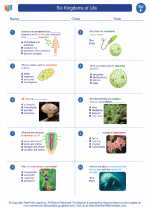
 Worksheet/Answer key
Worksheet/Answer key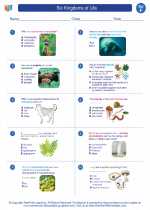
 Worksheet/Answer key
Worksheet/Answer key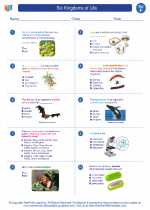
 Vocabulary/Answer key
Vocabulary/Answer key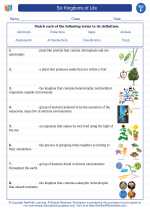
 Vocabulary/Answer key
Vocabulary/Answer key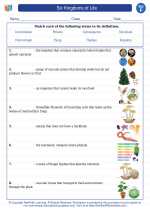
 Vocabulary/Answer key
Vocabulary/Answer key
